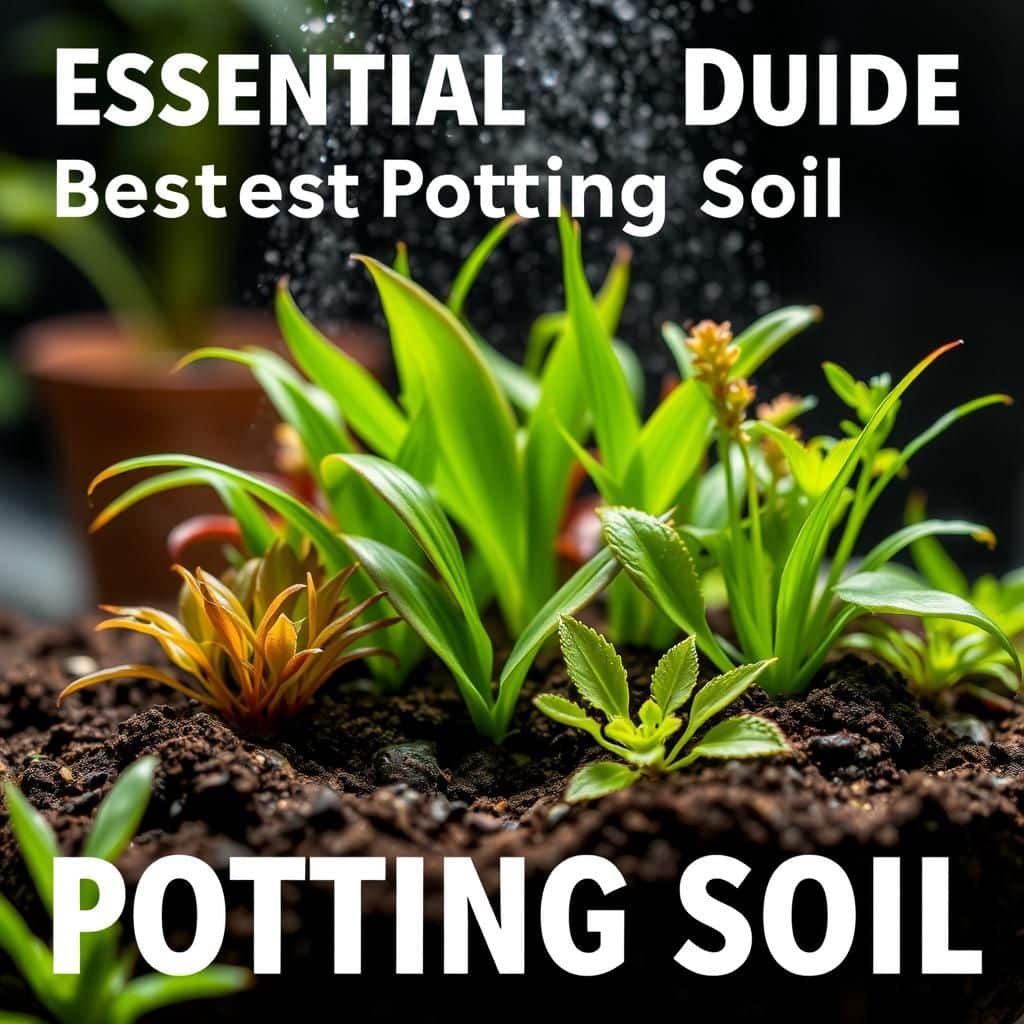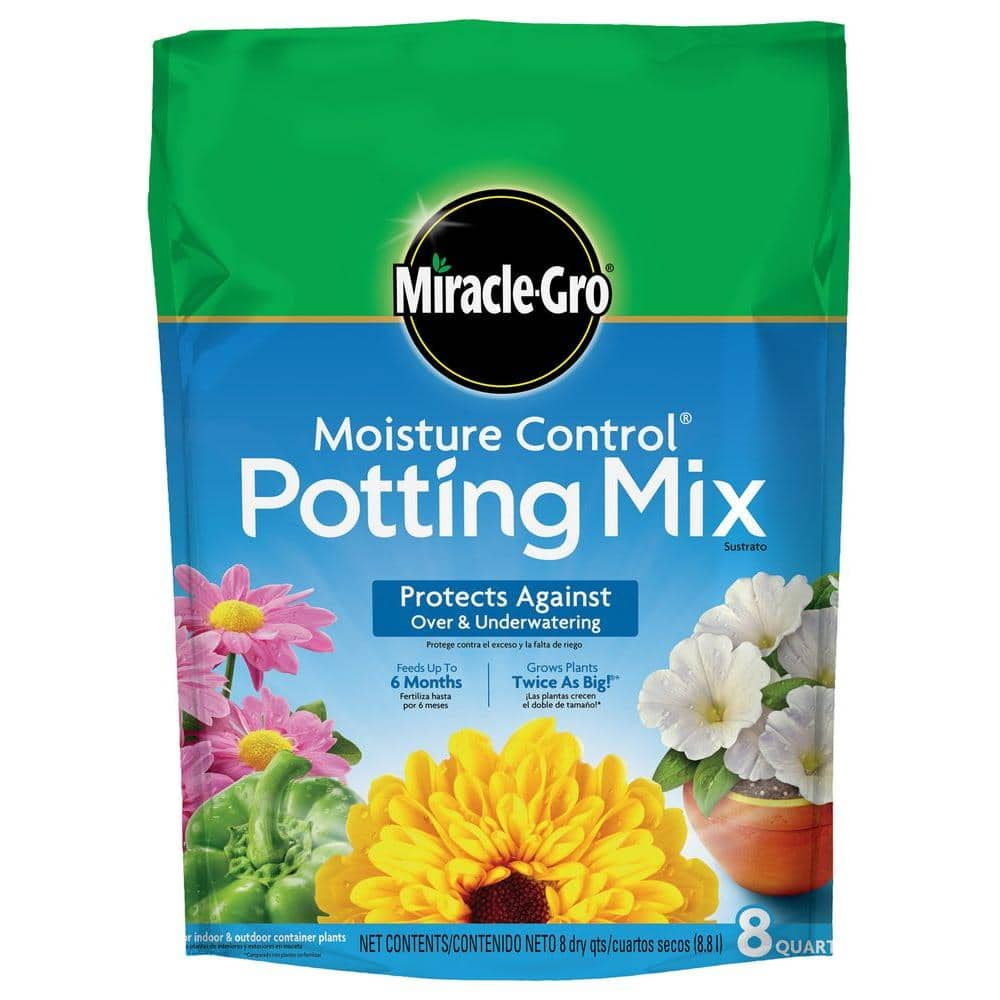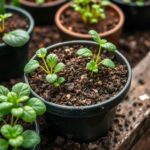Essential Guide to Choosing the Best Potting Soil for Aquatic Plants

Selecting the right potting soil is crucial for the successful growth of aquatic plants. With a variety of soil options available, understanding their specific properties can significantly impact the health and vitality of your underwater garden. This essential guide delves into the key factors to consider when choosing potting soil for aquatic plants, including nutrient balance, water retention, and pH levels. Whether you are setting up a serene pond or an elaborate aquarium, making informed decisions about your soil can enhance plant growth and create a thriving aquatic ecosystem. Discover the best practices to ensure your plants flourish in their watery environment.
Choosing the Right Potting Soil for Aquatic Plants
When selecting the appropriate potting soil for aquatic plants, it's crucial to understand their unique requirements. Unlike traditional plants, aquatic plants thrive in nutrient-rich, yet well-draining substrates that can retain moisture without becoming waterlogged. A good potting soil for these plants should typically include a blend of organic materials, such as peat moss, coconut coir, and clay aggregate, which provide the necessary nutrients while allowing for proper aeration. Additionally, it's important to avoid soils that contain chemicals or additives harmful to aquatic life. Using specialized aquatic potting mixes designed for submerged and emerged plants will enhance their growth and overall health.
Importance of Aeration in Potting Soil
Good aeration in potting soil is vital for aquatic plants as it allows oxygen to reach the roots while facilitating drainage. Roots that are consistently surrounded by water without sufficient air pockets may rot, leading to plant deterioration. An ideal mix will have enough structure to support roots while preventing compaction. Thus, including materials like lava rock or expanded clay pellets can help maintain the right balance between moisture retention and aeration.
Ideal Ingredients for Aquatic Plant Soil
The ideal potting soil for aquatic plants typically comprises a combination of organic and inorganic materials. Peat moss and coconut coir contribute to moisture retention and nutrient availability, while gravel or sand improves drainage and aeration. Additionally, some gardeners may opt to include clay pellets or perlite for enhanced aeration. Each of these ingredients plays a role in creating a stable environment for healthy root development and plant growth in aquatic settings.
Choosing Soil for Submerged vs. Emerged Aquatic Plants
Different types of aquatic plants—submerged versus emerged—require variations in soil composition. Submerged plants, which grow fully underwater, benefit from finer soils that can hold nutrients, while emerged plants, partially above water, may thrive better in coarser mixes that allow for proper drainage. Understanding these differences is essential for providing the best conditions for each type of plant, ensuring that the substrate supports their specific growth habits and environmental needs.
pH Levels and Nutrient Balance
Maintaining the appropriate pH levels and nutrient balance in potting soil for aquatic plants is crucial for their growth. Most aquatic plants prefer a slightly acidic to neutral pH of around 6.0 to 7.5. Using products like organic fertilizers can help sustain nutrient levels over time, but regular monitoring of both pH and nutrient content is essential to prevent deficiencies or toxic buildup. Adopting a proactive approach will ensure that aquatic plants receive balanced nutrition in their growing environment.
Importance of Regular Soil Maintenance
Regular maintenance of potting soil is important in ensuring continued health for aquatic plants. This includes monitoring moisture levels, checking for compaction, and occasionally refreshing or replacing the soil to prevent nutrient depletion. Additionally, removing any decaying matter or algae build-up can help maintain a healthy ecosystem within the pot. By keeping the growing environment clean and well-aerated, gardeners can enhance the longevity and vitality of their aquatic plants.
| Ingredient | Role |
|---|---|
| Peat Moss | Moisture retention and nutrient provision |
| Coconut Coir | Improves aeration and moisture holding |
| Gravel | Enhances drainage |
| Clay Pellets | Promote aeration and reduce compaction |
| Sand | Facilitates drainage and aeration |
Which soil is best for aquarium plants?

The best soil for aquarium plants plays a crucial role in their growth and overall health. Selecting the appropriate substrate is essential for providing the necessary nutrients, supporting the plants' root systems, and creating a balanced environment. Here are the key soil types that are commonly recommended for aquarium plants:
Types of Soil for Aquarium Plants
Different types of soil can be utilized in aquarium settings. Each type offers unique benefits depending on the plants you wish to cultivate.
- Substrate-Specific Soil - This is specially formulated for aquatic plants, containing essential nutrients and minerals, increasing plant growth and health.
- Clay-Based Soil - Clay substrates offer excellent nutrient retention capabilities and provide a natural environment that mimics riverbeds.
- Gravel - Inert gravel can be used for low-light or low-demand plants, serving primarily as a base substrate while allowing roots to penetrate.
- Laterite - A red clay soil rich in iron, laterite can provide a significant boost in nutrient availability, particularly for heavy feeders.
- Sand - Fine-grained substrates can be suitable for specific plants but often require additional fertilization to support healthy growth.
Nutrient-Rich Substrates
Using a nutrient-rich substrate is vital for promoting healthy growth in aquarium plants. Such substrates contain micronutrients and macronutrients essential for plant vitality.
- Macro-nutrients - Elements like nitrogen, phosphorus, and potassium are crucial for plant growth and development.
- Micro-nutrients - Elements such as iron, manganese, and zinc are needed in smaller amounts but are equally important for overall health.
- Slow Release - Choosing substrates that release nutrients slowly helps maintain a steady supply for plant uptake.
Layering Techniques
Layering different types of soil can enhance nutrient availability and improve plant anchoring.
- Base Layer - A heavy nutrient-rich substrate can be placed at the bottom to ensure nutrient retention.
- Top Layer - Lighter substrates, such as sand or fine gravel, can be added on top to create a natural appearance.
- Thickness - Ensure that the soil layer is thick enough to support plant roots without compacting, allowing for healthy growth.
pH Levels and Soil Choice
Choosing the right soil also involves considering its impact on the overall pH levels in the aquarium.
- Acidity/Alkalinity - Some soils can increase or decrease pH levels; assessing your plants' needs is crucial.
- Buffering Capacity - Some substrates can help buffer changes in pH, stabilizing the water chemistry.
- Compatibility - Ensure the chosen soil does not adversely affect other aquatic life or plants within the tank.
Care and Maintenance of Soil
Maintaining the soil is essential for ensuring a healthy aquatic ecosystem.
- Regular Cleaning - Regularly siphon debris and waste that can accumulate on the substrate surface without disturbing the soil structure.
- Monitoring Fertilization - Supplement nutrients as necessary, especially in low-nutrient substrates that may lack essential elements.
- Periodic Replacement - Over time, soil can lose its effectiveness; periodic replacement may be necessary to maintain plant health.
Can you use normal soil for aquatic plants?

Using normal soil for aquatic plants is generally not recommended. While it may be tempting to use garden soil due to its accessibility and low cost, several factors make it unsuitable for aquatic environments.
See also:
Soil Composition
Normal soil is composed of various organic and inorganic matter, which can lead to complications when used in an aquatic setting.
- Organic Matter: Regular soil contains high levels of organic material that can decompose in water, leading to the release of harmful substances.
- Inorganic Particles: The presence of larger particles can cause turbidity, making it difficult for aquatic plants to absorb light efficiently.
- pH Levels: Normal soil often has a different pH than aquatic plants require, potentially harming their growth.
Nutrient Availability
Aquatic plants have specific nutrient requirements, and normal soil might not provide the right balance.
- Macro and Micronutrients: While soil can contain nutrients, the availability in a submerged environment may lead to deficiencies for aquatic plants.
- Controlled Release: Fertilizers in commercial aquatic plant substrates are designed for slow release, unlike conventional soils.
- Imbalance: Over time, normal soil may lead to an imbalance of nutrients, causing algae overgrowth and plant stress.
Water Quality
Using normal soil can severely impact the quality of water in aquatic environments.
- Pollution: Soil can introduce pathogens and pollutants into the water, which are harmful to aquatic life.
- Turbidity: Large particles can lead to cloudy water, blocking light and reducing photosynthesis.
- Oxygen Levels: Decomposing organic matter can decrease dissolved oxygen levels, stressing both plants and fish.
Alternatives to Normal Soil
There are better alternatives specifically designed for aquatic plants.
- Aquatic Plant Substrate: Commercial substrates are formulated to be lightweight and promote root growth without degrading.
- Sand and Gravel: These materials provide excellent drainage and aeration while maintaining water quality.
- Clay Balls: Clay can be beneficial as it provides nutrients and serves as a substrate without affecting water quality.
Managing Aquatic Plant Growth
Proper care and management strategies are crucial for the success of aquatic plants.
- Water Fertility: Monitor nutrient levels through water tests to ensure adequate availability.
- Plant Placement: Position plants appropriately based on their light needs and water depth.
- Regular Maintenance: Remove excess debris and monitor for algae growth to maintain a healthy environment.
What potting mix do you use for water plants?

To choose the right potting mix for water plants, it's essential to consider the unique needs of these aquatic species. Generally, a well-draining and nutrient-rich medium is required to support the plants while allowing for adequate oxygen flow to the roots. Here are some key components commonly found in potting mixes specifically suited for water plants:
1. Aquatic Soil: This is specially designed for submerged and floating plants. It typically comprises clay-based materials which promote root growth and nutrient absorption.
2. Sand: Ensures excellent drainage, preventing water from becoming stagnant. It's crucial for plants like water lilies and other submerged varieties.
3. Organic Matter: Adding compost or aged manure provides essential nutrients, fostering healthy plant growth.
4. Perlite or Vermiculite: These lightweight materials enhance aeration in the soil, ensuring the roots receive enough oxygen.
5. Gravel or Small Stones: Often used as a top layer, gravel helps keep the mix in place and prevents it from being disturbed by water movement.
Here are five relevant sections discussing the potting mixes for water plants:
1. Key Ingredients in Water Plant Potting Mix
The composition of your potting mix is vital for the wellbeing of water plants. The ideal mix typically includes a combination of:
- Aquatic Soil - Provides a stable base with clay that retains nutrients.
- Sand - Promotes drainage and prevents root rot.
- Organic Matter - Supplies essential nutrients and supports microbial activity.
2. Importance of Drainage
Drainage is crucial for water plants because stagnant water can lead to root suffocation and decay. To ensure proper drainage:
- Choose a mix that incorporates sufficient sand or perlite.
- Avoid heavy potting soils that retain too much moisture.
- Consider using a pot with drainage holes or a layered approach with gravel.
3. Nutrient Management
Nutrient availability is critical for the growth of water plants. Incorporating organic materials can significantly enhance the nutrient profile:
See also:
- Use compost or well-rotted manure to enrich the mix.
- Consider slow-release fertilizers designed for aquatic plants.
- Regularly monitor and replenish nutrients based on plant growth and water quality.
4. Special Considerations for Different Types of Water Plants
Different water plants have unique requirements for potting mixes based on their growth habits:
- Submerged plants like elodea prefer a denser soil that retains more moisture.
- Floating plants like duckweed thrive in lighter, well-aerated mixes.
- Margin plants often do well in a mix that includes more organic material for better support.
5. Maintenance of Potting Mix for Water Plants
After establishing water plants, maintaining the potting mix is essential for longevity and health:
- Regularly check the mix for compaction and replenish as needed.
- Remove any decaying plant matter to prevent decomposition-related issues.
- Monitor water quality and adjust nutrient levels to suit plant needs.
Can you use normal potting soil for an aquarium?

Using normal potting soil for an aquarium is generally not recommended, particularly for freshwater tanks. Potting soil is designed for plants and may contain additives such as fertilizers, pesticides, and other chemicals that can harm aquatic life. Here’s a detailed examination of the topic, along with related subtopics.
Understanding Potting Soil Composition
Potting soil is composed of various materials designed to provide optimal conditions for terrestrial plants. The elements commonly found in potting soil include:
- Organic Matter: Peat moss, compost, and bark are used to retain moisture and provide nutrients.
- Fertilizers: Many potting soils contain added fertilizers to promote plant growth.
- pH Adjusters: Some soils may have chemicals to adjust the pH level which can be detrimental to fish.
The components in potting soil that cater to land plants are often unsuitable for use in an aquatic system.
Impact on Water Quality
Using potting soil can have a significant negative impact on the quality of water within an aquarium. The following aspects may arise:
- Nutrient Release: Potting soil can leach excess nutrients into the water, promoting algae blooms.
- Turbidity: Fine particles from the soil can cause the water to become murky.
- Toxic Compounds: Some additives may release toxins that adversely affect fish health.
Maintaining water quality is crucial for the health of aquatic organisms, making potting soil a poor choice.
Alternative Substrates for Aquariums
For aquarium setups, there are various substrates that are specifically formulated to cater to aquatic environments. Consider these options:
- Aquarium Gravel: Provides a natural look and allows for good water flow.
- Sand: Suitable for certain species of fish and can help with filtration.
- Specialized Plant Substrates: Products like aquarium plant soil are designed to provide nutrients without harmful additives.
Choosing a suitable substrate is essential for the overall health of the aquarium.
Plants and Potting Soil Compatibility
While some aquarium enthusiasts may want to introduce plants, using potting soil is not the best route. Here’s why:
- Water Compatibility: Most plants thrive in specialized aquatic soils that prevent nutrient loss.
- Root Development: Aquatic substrates promote healthier root systems compared to potting soil.
- Nutrient Balance: Aquatic plant soils provide essential nutrients without the risk of toxic substances.
Healthy plants contribute positively to the ecosystem, underscoring the need for proper substrate.
Best Practices When Setting Up an Aquarium
When setting up a new aquarium, follow these best practices to ensure a thriving environment:
- Research Substrate Options: Investigate the specific needs of your fish and plants.
- Test Water Parameters: Regularly check water pH, hardness, and nutrients.
- Avoid Contaminated Materials: Only use products designed for aquatic systems to prevent harmful effects.
Adhering to these guidelines will lead to a successful aquarium setup.
Questions from Our Readers
What is potting soil for aquatic plants?
Potting soil for aquatic plants is a specially formulated growing medium designed to provide the necessary nutrients and drainage for plants that thrive in or around water. Unlike traditional potting soil, it often contains materials that allow for good water retention while preventing compaction, ensuring an ideal environment for aquatic plant roots.
Can I use regular potting soil for aquatic plants?
Using regular potting soil for aquatic plants is generally not recommended, as it can become saturated and lead to poor drainage. This can suffocate the roots of the plants and promote undesirable conditions, such as algae growth. Instead, it is best to use a potting soil specifically designed for aquatic plants.
See also:
What ingredients should I look for in aquatic potting soil?
When selecting potting soil for aquatic plants, look for organic matter like peat moss, clay, and gravel that promote proper aeration and water retention. It's also beneficial to choose a soil that is free from synthetic fertilizers and contains necessary minerals to nourish aquatic plants effectively.
How often should I change or refresh the potting soil for my aquatic plants?
You should refresh the potting soil for your aquatic plants approximately every 1 to 2 years, depending on how quickly the soil breaks down and the needs of your plants. Regularly checking for decomposition or compaction will help ensure that the soil continues to provide a healthy environment for your plants.

If you want to read more articles like Essential Guide to Choosing the Best Potting Soil for Aquatic Plants, we recommend you check out our Soil category.
Leave a Reply
Related Articles